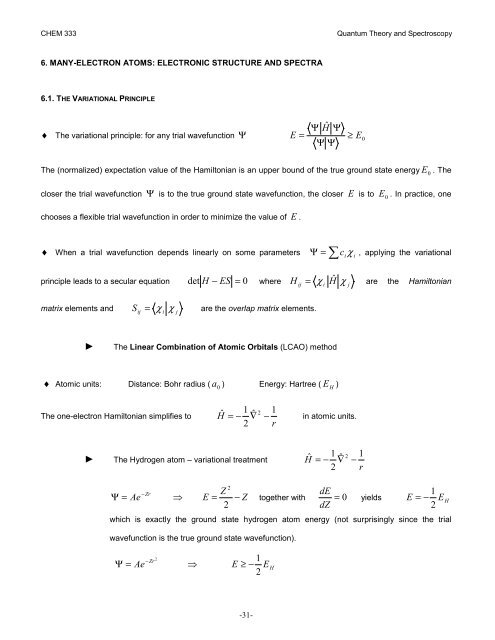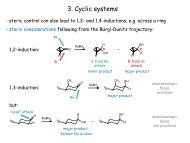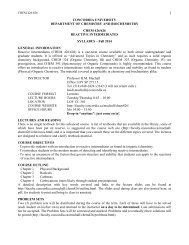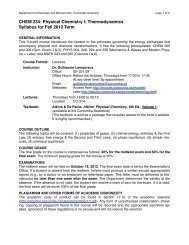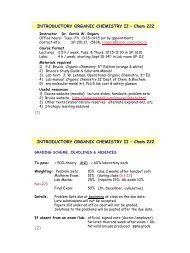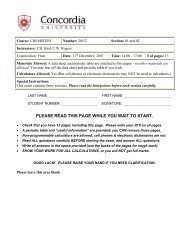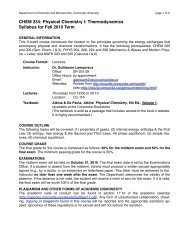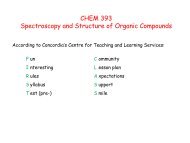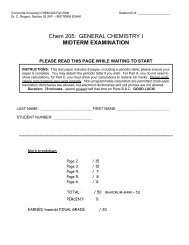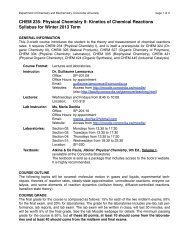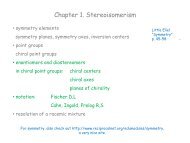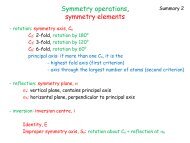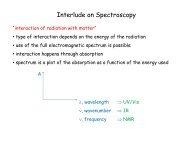6. Many-Electron Atoms: Electronic Structure and Spectra
6. Many-Electron Atoms: Electronic Structure and Spectra
6. Many-Electron Atoms: Electronic Structure and Spectra
You also want an ePaper? Increase the reach of your titles
YUMPU automatically turns print PDFs into web optimized ePapers that Google loves.
CHEM 333Quantum Theory <strong>and</strong> Spectroscopy<strong>6.</strong> MANY-ELECTRON ATOMS: ELECTRONIC STRUCTURE AND SPECTRA<strong>6.</strong>1. THE VARIATIONAL PRINCIPLEΨ HˆΨ♦ The variational principle: for any trial wavefunction Ψ E = ≥ E0Ψ ΨThe (normalized) expectation value of the Hamiltonian is an upper bound of the true ground state energy E 0. Thecloser the trial wavefunction Ψ is to the true ground state wavefunction, the closer E is to E0. In practice, onechooses a flexible trial wavefunction in order to minimize the value of E .♦ When a trial wavefunction depends linearly on some parametersΨ =∑c χ , applying the variationaliiprinciple leads to a secular equation det H − ES = 0 where Hij= χiH χjare the HamiltonianSχχmatrix elements <strong>and</strong>ij=i jare the overlap matrix elements.ˆ►The Linear Combination of Atomic Orbitals (LCAO) method♦ Atomic units: Distance: Bohr radius ( a0) Energy: Hartree ( EH)The one-electron Hamiltonian simplifies toHˆ1− ∇ˆ21r= 2 − in atomic units.►The Hydrogen atom – variational treatmentHˆ1= − ∇ˆ22 −1r2Z= 2Ψ = Ae −Zr ⇒ E − ZdEdZtogether with = 0yieldsE1= −2which is exactly the ground state hydrogen atom energy (not surprisingly since the trialwavefunction is the true ground state wavefunction).21Ψ = Ae −Zr ⇒ E ≥ − EH2EH-31-
CHEM 333Quantum Theory <strong>and</strong> Spectroscopy<strong>6.</strong>3. SPECTROSCOPYSpin states♦ Singlet <strong>and</strong> triplet states. Spin multiplicity♦ Spin-orbit coupling splits atomic energy levelsTerm Symbols2 S +1{} L Jl1 l ,....., l l♦ Total orbital angular momentum = +2 1−2LConfiguration term symbols are S ( L = 0)P ( L = 1)D ( L = 2)…♦ Spin multiplicity: 2 + 1♦ Total angular momentum JS = s1 + s ,....., s − sS where the total spin is2 1 2Weak spin-orbit coupling (light atoms): Russell-Saunders rulesJ= L + S,.....,L − SExample of term symbols:1Ne]3⇒1/ 21 1]2 3[ p[ Ne p p ⇒22 P <strong>and</strong>3/ 22 P3 D1 D , 3 D1, 3 D2<strong>and</strong>31 P1, 3 P0, 3 P1<strong>and</strong> 3 P21 S0<strong>and</strong> 3 S1Spectroscopic Selection Rules∆S = 0 ∆L = ± 1 ( ∆l = ±1)∆J = 0 , ± 1 (except for J = 0 to = 0Selection rules break down for heavy atoms !!J )Examples of allowed transitions:3 / 21/ 22222P ← SP3 / 2← S1/2-33-


